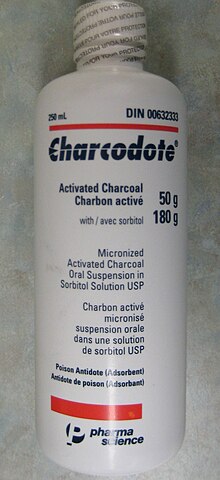Activated charcoal, or activated carbon, is used as a medication to treat poisonings following excessive oral ingestion of certain medications or poisons. Side effects may include aspiration into the lungs.
It is on the World Health Organization's List of Essential Medicines, the most important medications needed in a basic health system. It costs wholesale between 0.01 and 0.02 USD per 125 mg pill.

Activated charcoal for medical use.
Medical Uses
Poison Ingestion
While it is used to treat many types of oral poisonings, there is no good evidence that it improves outcomes. It is not effective for a number of poisonings including: strong acids or bases, iron, lithium, arsenic, methanol, ethanol or ethylene glycol. In a study of acute poisonings from agricultural pesticides and yellow oleander seeds, the administration of activated carbon did not affect survival rates of patients.
Gastrointestinal tract-related in issues
Charcoal biscuits were sold in England starting in the early 19th century, originally as remedy to flatulence and stomach trouble.
Tablets or capsules of activated carbon are used in many countries as an over-the-counter drug to treat diarrhea, indigestion, and flatulence. There is some evidence of its effectiveness to prevent diarrhea in cancer patients who have received irinotecan. It can interfere with the absorption of some medications, and lead to unreliable readings in medical tests such as the guaiac card test. Activated carbon is also used for bowel preparation by reducing intestinal gas content before abdominal radiography to visualize bile and pancreatic and renal stones. A type of charcoal biscuit has also been marketed as a pet care product.
Side EffectsIncorrect application (e.g. into the lungs) results in pulmonary aspiration which can sometimes be fatal if immediate medical treatment is not initiated. The use of activated carbon is contraindicated when the ingested substance is an acid, an alkali, or a petroleum product.
Mechanism of action
Active charcoal binds the poison and prevents its absorption by the gastrointestinal tract. In cases of suspected poisoning, medical personnel administer activated carbon on the scene or at a hospital's emergency department. In rare situations, it may also be used in a hemoperfusion system to remove toxins from the blood stream of poisoned patients. Activated carbon has become the treatment of choice for many poisonings, and other decontamination methods such as ipecac-induced emesis or stomach pumping are now used rarely.
Mechanisms of action:
- Binding of the poison to prevent stomach and intestinal absorption. Binding is reversible so a cathartic such as sorbitol may be added as well.
- It interrupts the enterohepatic and enteroenteric circulation of some drugs/toxins and their metabolites.
- ^ "WHO Model List of EssentialMedicines" (PDF). World Health Organization. October 2013. Retrieved 22 April 2014.
- ^ "Charcoal, Activated". International Drug Price Indicator Guide. Retrieved 13 August2015.
- ^ a b "Charcoal, Activated". The American Society of Health-System Pharmacists. Retrieved 23 April 2014.
- ^ Eddleston M, Juszczak E, Buckley NA; et al. (2008). "Multiple-dose activated charcoal in acute self-poisoning: a randomised controlled trial". Lancet 371 (9612): 579–87. doi:10.1016/S0140-6736(08)60270-6 PMC 2430417. PMID 18280328.
- ^ Rolland, Jacques L. (2006). The Food Encyclopedia: Over 8,000 Ingredients, Tools, Techniques and People. Robert Rose. p. 148. ISBN 0-7788-0150-0.
- ^ Stearn, Margaret (2007). Warts and all: straight talking advice on life's embarrassing problems. London: Murdoch Books. p. 333. ISBN 978-1-921259-84-5. Retrieved 2009-05-03.
- ^ Michael M, Brittain M, Nagai J; et al. (Nov 2004). "Phase II study of activated charcoal to prevent irinotecan-induced diarrhea". J Clin Oncol. 22 (21): 4410–7. doi:10.1200/JCO.2004.11.125. PMID 15514383.
- ^ Gogel HK, Tandberg D, Strickland RG (Sep 1989). "Substances that interfere with guaiac card tests: implications for gastric aspirate testing". Am J Emerg Med 7 (5): 474–80. doi:10.1016/0735-6757(89)90248-9. PMID 2787993.
- ^ Elliott C, Colby T, Kelly T, Hicks H (1989). "Charcoal lung. Bronchiolitis obliterans after aspiration of activated charcoal". Chest 96 (3): 672–4. doi:10.1378/chest.96.3.672. PMID 2766830.
Wikipedia





No comments:
Post a Comment